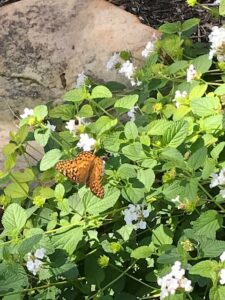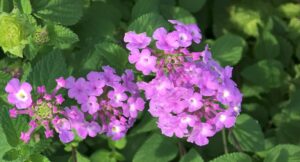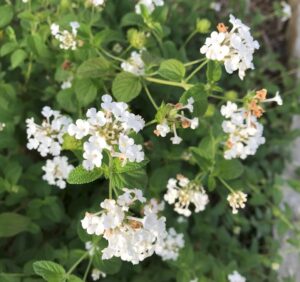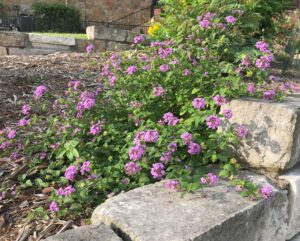
Butterflies visit spring through fall.
Trailing Lantana is a ‘Go-To’ Plant
In Central Texas, Lantana is a ‘go to’ garden specimen for continuous color from spring through fall. It survives our inconsistent freezes, drought, and periods of rain deluge and just keeps coming back.
The purple variety of Trailing Lantana is slightly more hardy than the white, but both are plants you’ll want to have in your garden. The white variety can take more shade than the purple, but still flowers best with direct sun and heat.

Clusters of small flower clusters amidst a light green background of foliage.
As with all lantanas, the foliage has a distinct herbal smell which deters most wildlife. The only time a deer has ‘tasted’ a lantana in my yard was as a new planting of a small specimen. The foliage can be a skin irritant, but I experience less of an issue with the smaller Trailing Lantana than I do with the larger bush varieties.
Whichever color you prefer, the butterflies will thank you for the lovely blooms and pollen from early spring until the first frost. It’s not unusual to see various varieties of butterflies visit the plants all summer long.
Propagation Can Happen Naturally
Trailing Lantana can be propagated in two ways: rooted stems and stem cuttings.
Rooted Stems
Trailing Lantana self propagates by developing roots along the long trailing arms. Once rooted, you can easily lift the plant and roots and relocate to a new spot, or put into a container for a flush of blooms. Spring is the best time to transplant these ‘volunteers’ to provide the new plants the lower temperatures to establish deeper roots before the heat of summer arrives.

White flower clusters can enhance any garden type.
There is no trick needed to gain multiple plants from the ‘mother plant’, but patience may be needed to allow the small roots to develop. Don’t want additional plants? Just gently pull-up the roots and the thin arm will continue to develop foliage and blooms while the hair-like roots wither.
Stem Cuttings
To propagate by stem cuttings, it’s best to take a cutting in the spring or early summer while the plant is actively growing.
Ideally, take a 6-8 inch cutting which provides several nodes. (A node is the area where leaves have emerged from the stem.) Remove all leaves but the top two-to-three to allow the plant to focus on root development instead of leaf and flower development. Place the cutting in well-drained medium, keep moist (not soggy), and store in indirect sun. Within a couple of weeks, you should see new leaves developing, which is a sign roots have developed. At this stage, take a week to ‘harden off’ the plant by exposing it to increasing levels of direct sun. After a week of full exposure, the plant is ready for it’s new home.
Nearly Maintenance Free and Forgiving
Trailing Lantana will die back after the first frost, and it’s a great wildlife offering to allow the thin wooden limbs to remain throughout the winter months. Since low to the ground, the myriad of brown limbs provide shelter to insects.

Lantanas are drought tolerant after the first year.
After the threat of a freeze has passed in the spring, I inspect the limbs, as if it’s one of those winters with no hard freeze, green growth may emerge from the existing limbs while new limbs are also growing. If we’ve had a hard freeze, I cut back the limbs to about 8 inches from the main stem.
Spring is also a good time to check to see if the stem has expanded or duplicated. If so, it’s very easy to dig up, split and replant where you desire. I find there’s always another spot for a plant that blooms all summer, especially in areas where more fragile plants have failed.
And since drought tolerant after the first year, if you forget to water your lantana and it’s drooping and looking a little thirsty – do not fret! Just give the plant a good soaking and it will come back within hours and look as though it never missed a drink. Now that’s the level of maintenance I like during weeks with 100F+ temperatures.
What is a Texas Superstar plant?
The Texas Superstar® program was created by horticulturists to identify and select plants that can be grown across the state of Texas with high confidence in the quality and reliability of the plant. Selections for the program are based upon observations made at replicated plots and demonstration trials across the state and final selection is made by the Texas Superstar® Executive Board.
Additional Resources
Best Bee-Friendly Plants for Austin
About Yvonne Schneider

Yvonne was a 35+year veteran in the computer and information technology industry when she retired and moved from Houston to the Austin area. In 2018, Yvonne certified as a Travis County Texas Master Gardener to follow her passion for gardening and volunteering within the community. She has spent 20+ years enjoying gardening and working with bulbs and perennials. She now tackles the challenges presented by the Austin area wildlife, drought, and limestone soil.

